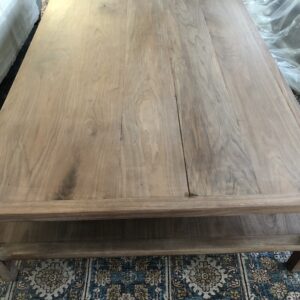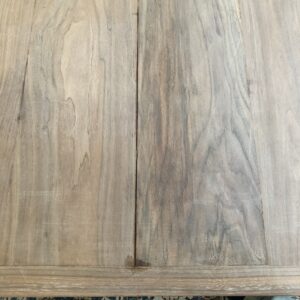Hi all,
Hope all is well. I’m in the process of refinishing my walnut coffee table. I noticed that over a few months, a gap between two glue joined boards emerged. Should I put some wood filler in this seam or just let it be as part of the table’s natural patina? Love to hear your thoughts. Thanks!
















Replies
Maybe a glue starved joint, and as the wood shrinks it might continue on its journey if you don't fix it properly.
I don't see any pins in the breadboard. If you glued them on, there's the source of the problem.
To fix properly: remove BB ends, rip seam apart, rejoint and glue. Then reattach (or leave off) BB's.
Agree with RobertEJr. It looks good now if only the wood does not shrink to much more. If you want to try fastening battens underneath to limit the widening of the split, you could always make the fix later if the wood shrinks too much.
The "breadboards" don't look like breadboards but, rather, rails between the legs, which may be tenoned into those legs. But the long sides of the top may be tenoned into the legs too. .....?
If so, the result will be the same as a breadboard glued along the whole edge of a table top edge, as the differential expansion and contraction of top's end grain against the rail's long grain means ..... crack! There's nothing in such joinery to accommodate that differential expansion and contraction.
The rails will be difficult to remove. But so will the top. Effectively, the legs & rails would have to be sawn off from the top. And then the issue is: what to use as a substitute joinery to rejoin the parts whilst including some means to allow for that differential contraction/expansion?
The bottom shelf looks as though the same joinery may have been used as was used for the top. A crack may appear there too, eventually.
One approach is to live with the crack. Many an antique piece sufferes the same problem, after all.
**********
On the other hand, it would be possible to saw off the top (and the shelf) then remount them into rebates let into the top and bottom end rails and top-ends, via a spline glued only in the middle so that the end assemblies of legs and rails become a sort of double breadboard.
The top and shelf might need some additional supports besides the unglued ends of the splines at their outside corners, though (where they abutt the legs) - perhaps some decorative brackets glued or tenoned into the legs under the top and shelf?
Lataxe
You say you are refinishing the table, did you also build it? I have some concerns that the construction and design did not account for wood movement adequately and will continue to be a problem in the future. I don't feel filler is an option because if the wood shrank due to dry winter air it will expand again when the humidity increases again this summer and pop out the filler or worse cause other joints to fail. I think outside of rebuilding the table to accommodate wood movement better you will just need to accept it.
Agree, you need to disassemble and rebuild. There are some excellent articles in edge jointing you can review, and as noted you need to concern yourself with seasonal wood movement.
While the comments re wood movement are spot on, I'm going to suggest that instead of a rebuild, you just live with it. Depending on age, and the environment in which the table lives, it may be that you've now seen the worst of it, and as the piece ages further, it'll become as much a "feature" as a flaw. Certainly easier to do this than saw apart, rebuild, etc.--and you can always go that route later should the crack worsen or you decide you can't live with it, etc.
I agree I may just let it be. It was my first coffee table but i think it will adds character. Yes, it was all joined together using glue and the domino tenons, including the legs. Thought that would be strong enough to keep everything intact. But I guess the one board cupped a bit too much.
Use this table as an example of the importance of designing and building with wood movement in mind. There is a fundamental design flaw in the way you inlaid the table top inside what appears to be 2"x 2" frame with no way for the solid wood top to move as seasonal humidity changed. It was doomed to fail not by the construction techniques per se but by the design. A better design would have been to have the top sit on top of the framework with a center screw pinning the center and slotted screw holes along the short side to allow for wood movement while keeping the top flat and attached to the frame. No screws should be attache to the frame along the long edge unless they too were slotted parallel to the short side.
I suggest reading the many articles on FW on how to design and build with wood movement in mind.
This forum post is now archived. Commenting has been disabled